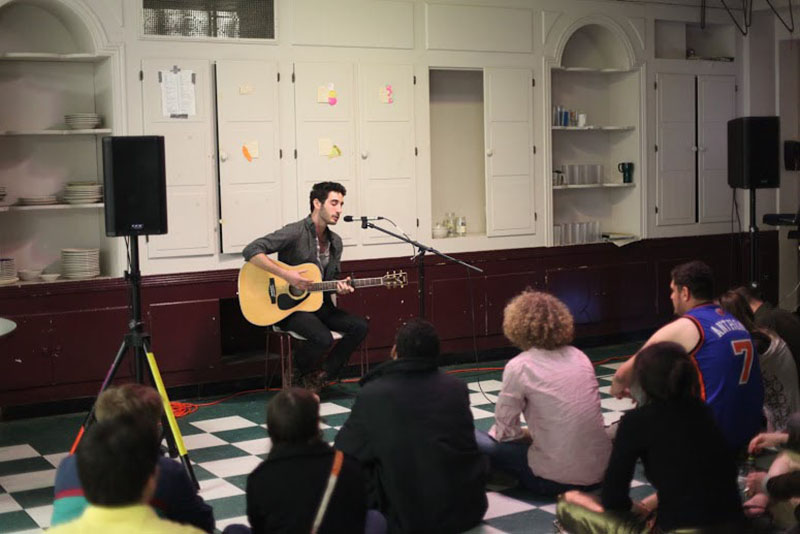CS Exhibition Pushes Limits of Technology as Art
College senior Oren Shoham performs a number of covers at the Computer Science Community Art Show on April 26. Held in the basement of Harkness, the exhibition included interactive art, projections, graphic art, performance art, literary works and a few exhibits that were utterly unclassifiable.
May 2, 2014
If the Computer Science Community Art Show were to be described in one word, that word would silently be pulled from the brain by a headset, fed into a seismograph and read as a beautiful array of colored lines. Although the featured artists at the event held on April 26 in Harkness House’s basement were not typical visual or performanceartists, the Computer Science department’s offerings were diverse and impressive enough to rival and perhaps trump Oberlin’s Studio Arts program. While made up of relatively few contributors, the exhibition featured interactive art, projections, graphic art, performance art, literary art and a few exhibits that were totally unclassifiable. Judging by this exhibition, it wouldn’t be surprising if fiveyears from now, Oberlin supported a thriving outsider arts community nestled comfortably behind computer keyboards and Oculus Rift gear.
More striking than any single performer or exhibited artist was the originality and diversity of the pieces, which caused those in attendance to question the definition of “art.” Displays included headgear that responded to brainwaves, circuit boards that produced sound when tinkered with, a simple video game, a randomized light display and projections that subtly responded to motion. These computer science majors crossed lines the Art department usually doesn’t. “Is a machine not art?” the exhibition seemed to ask.
Not all artists intended to push limits solely through their artistic media. College senior Meg Davis, whose digital prints were pinned neatly in a corner, challenged her viewers to brave the realities of the difficult experiences that define many Oberlin students’ lives: sexual trauma and eating disorders. While the artist’s 10-plus digital prints reflected great artistic talent, the experiences transferred via text were difficult to digest. Davis’s courage came through inher work. Rather than hide her frustration and disillusionment with Oberlin’s opaque Sexual Offense Policy, she pinned it on the wall. One particularly striking element was a quotation pulled from Oberlin’s (hopefully) soonto-be-forgotten vice, Obietalk. The quotation, which seemed to describe one student’s attempt to find justice for sexual assault, was printed on a plain white piece of paper that accentuated its brutal message. While a picture may be worth a thousand words, this particular piece was worthier of an apology from anyone who ever made somebody feel so bleak.
The show was not totally technology-bound either. College senior Oren Shoham performed a number of covers, accompanied only by his acoustic guitar and the crowd that surrounded him. While covering Waxahatchee at an art show could easily seem corny, Shoham was able to capture the lyrical sincerity in his own voice. He surpassed the audience’s expectations, and, had it not been for a charming rendition of “Wagon Wheel” by Old Crow Medicine Show, the entire first row likely would have spent the rest of their Friday night weeping.
Poetry and other short readings closed out the show. The first poet, College senior Krista LaFentres, displayed a knack for originality in line with the show’s diversity, and the second, double-degree junior Devon Wells, managed to elicit both laughter and nostalgia. He capped his performance by reading love letters a young crush had sent him in middle school. While clearly a humorous piece, there was something honest and innocent in the way his voice met his crush’s pen. It was almost impossible not to travel back to the days when a crush was satisfied by gigglesand mall dates.
Whether one was more enlightened by new ideas of where art begins and machinery ends or by the cold confrontation of the administration’s failure to effectively manage sexual assault and mental health issues or both, one would need to purposefully ignore the exhibition’s voice in order to leave unaffected. Hopefully this will not be the last exhibition to showcase the Computer Science department’s wealth of talent.


























